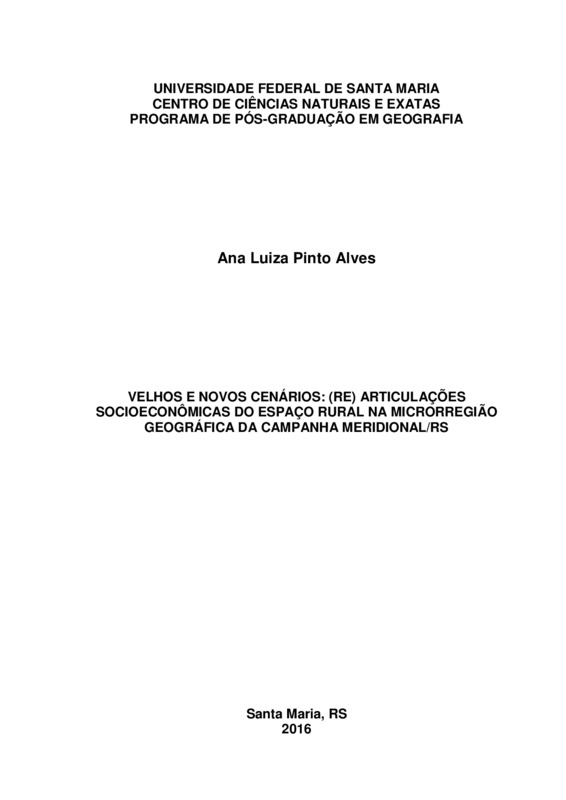-
Título
-
VELHOS E NOVOS CENÁRIOS: (RE) ARTICULAÇÕES SOCIOECONÔMICAS DO ESPAÇO RURAL NA MICRORREGIÃO GEOGRÁFICA DA CAMPANHA MERIDIONAL/RS
-
lista de autores
-
ANA LUIZA PINTO ALVES
-
Resumo
-
A ciência geográfica analisa o espaço produzido e/ou reproduzido pela sociedade ao longo da história, o qual é reorganizado frente às exigências impostas pelo capital e pelos atores econômicos. Neste contexto, a pesquisa tem como objetivo geral verificar as transformações do espaço rural da Microrregião Geográfica da Campanha Meridional, a sua origem, as mudanças e permanências, bem como as (re) articulações socioeconômicas. Especificamente, buscou-se: (a) resgatar a evolução socioespacial da Microrregião Geográfica da Campanha Meridional; (b) analisar o espaço produtivo do recorte espacial em estudo, para que se possa compreender a atual situação do setor agropecuário e (c) identificar as potencialidades e as fragilidades econômicas a serem exploradas, bem como as perspectivas de desenvolvimento regional. A Microrregião em análise está localizada na Metade Sul do Estado do Rio Grande do Sul, a qual é constituída por cinco municípios (Aceguá, Bagé, Dom Pedrito, Hulha Negra e Lavras do Sul), sendo considerada uma das microrregiões mais atrasadas economicamente, se comparada a outras microrregiões do Rio Grande do Sul. Esse recorte espacial alia sob a ótica da cultura, a política, com a formação de lideranças regionais que se perpetuam no poder e na economia local/regional por meio da coexistência da pecuária extensiva tradicional e da inserção de novos atores econômicos, que marcam a influência do capital como um agente que tenta romper as barreiras impostas por tradições seculares. Desta forma, justifica-se a releitura do espaço geográfico da Campanha Meridional, a qual permitirá identificar as potencialidades e/ou as fragilidades socioeconômicas a serem exploradas, atrelando-as aos aspectos físico-naturais e socioculturais, como pressupostos para a proposição de alternativas de desenvolvimento, contribuindo com estudos que visem dinamizar sua estrutura produtiva. Metodologicamente a pesquisa foi estruturada em etapas: 1ª levantamento bibliográfico; 2ª Coleta dados (fontes secundárias); 3ª trabalho de campo e 4ª análise e interpretação dos resultados. Neste sentido, pretende-se averiguar as transformações desse recorte espacial, buscando compreender sua dinâmica espacial e as transformações acarretadas pelo capital, as quais visam sua reorganização socioeconômica.
-
Abstract
-
The geographical science analyzes the space produced and/or reproduced by society throughout the history, which is rearranged in the face of demands imposed by capital and the economic actors. In this sense, the current research aims to verify the rural space transformations of the geographical micro-region called Campanha Meridional, its origin, changes and permanency as also the socioeconomic (re)articulation, and the prospects for regional development. Specifically, it sought to: (a) recover the socio-spatial evolution of the geographical micro-region Campanha Meridional; (b) analyze the productive space of the spatial area under study to understand the current situation of the agricultural sector, and (c) identify the economic potential and fragility to be explored. The analyzed micro-region is located in the southern half of Rio Grande do Sul state, which is composed of five counties (Aceguá, Bagé, Dom Pedrito, Hulha Negra and Lavras do Sul), and it is considered one of the most backward micro-regions compared with other micro-regions in the state of Rio Grande do Sul. This spatial area, that combines the perspective of culture, politics, with the formation of regional leaders who perpetuate themselves in power and local/regional economy through the coexistent traditional extensive livestock and integration of new economic actors, marking the influence of capital as an agent who "tries to" break down the barriers imposed by secular traditions. Thus, it is justified to rereading the geographical space of Campanha Meridional, which will allow identify the economic potential and/or fragility to be explored, linking the physical and natural, social and cultural aspects as assumptions to propose development alternatives, contributing with studies that aim to promote its productive structure. Methodologically the research was organized in steps: 1st bibliographic survey; 2nd the collection of data (secondary sources); 3rd field work; and 4th the analysis and interpretation of results. In this sense, was intended to investigate the changes in this spatial area, seeking to understand its spatial dynamics and the changes brought about by capital, which are aimed at its socioeconomic reorganization.
-
Palavras Chave
-
ORGANIZAÇĂO ESPACIAL
-
GEOGRAFIA AGRÁRIA
-
DESENVOLVIMENTO REGIONAL
-
CADEIAS PRODUTIVAS
-
Key Words
-
SPATIAL ORGANIZATION
-
AGRICULTURAL GEOGRAPHY
-
REGIONAL DEVELOPMENT
-
PRODUCTION CHAINS
-
Tipo
-
MESTRADO
-
Universidade
-
UNIVERSIDADE FEDERAL DE SANTA MARIA
-
Data
-
2016
-
Páginas
-
155
-
Localização
-
Biblioteca Digital de Teses e Dissertações (BDTD UFSM)
-
Orientador
-
MERI LOURDES BEZZI
-
Programa
-
Programa de Pós-Graduação em Geografia e Geociências
-
Sigla Universidade
-
UFSM
-
Área de Concentração
-
ANÁLISE AMBIENTAL E TERRITORIAL DO CONE SUL
-
Língua
-
Português
-
email
-
ANALUIZAPINTOALVES@GMAIL.COM

